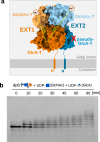Structure of the human heparan sulfate polymerase complex EXT1-EXT2
- PMID: 36402845
- PMCID: PMC9675754
- DOI: 10.1038/s41467-022-34882-6
Structure of the human heparan sulfate polymerase complex EXT1-EXT2
Abstract
Heparan sulfates are complex polysaccharides that mediate the interaction with a broad range of protein ligands at the cell surface. A key step in heparan sulfate biosynthesis is catalyzed by the bi-functional glycosyltransferases EXT1 and EXT2, which generate the glycan backbone consisting of repeating N-acetylglucosamine and glucuronic acid units. The molecular mechanism of heparan sulfate chain polymerization remains, however, unknown. Here, we present the cryo-electron microscopy structure of human EXT1-EXT2, which reveals the formation of a tightly packed hetero-dimeric complex harboring four glycosyltransferase domains. A combination of in vitro and in cellulo mutational studies is used to dissect the functional role of the four catalytic sites. While EXT1 can catalyze both glycosyltransferase reactions, our results indicate that EXT2 might only have N-acetylglucosamine transferase activity. Our findings provide mechanistic insight into heparan sulfate chain elongation as a nonprocessive process and lay the foundation for future studies on EXT1-EXT2 function in health and disease.
© 2022. The Author(s).
Conflict of interest statement
The authors declare no competing interests.
Figures





Similar articles
-
In vitro polymerization of heparan sulfate backbone by the EXT proteins.J Biol Chem. 2003 Oct 17;278(42):41333-7. doi: 10.1074/jbc.M308314200. Epub 2003 Aug 7. J Biol Chem. 2003. PMID: 12907669
-
Contribution of EXT1, EXT2, and EXTL3 to heparan sulfate chain elongation.J Biol Chem. 2007 Nov 9;282(45):32802-10. doi: 10.1074/jbc.M703560200. Epub 2007 Aug 29. J Biol Chem. 2007. PMID: 17761672
-
The putative tumor suppressors EXT1 and EXT2 form a stable complex that accumulates in the Golgi apparatus and catalyzes the synthesis of heparan sulfate.Proc Natl Acad Sci U S A. 2000 Jan 18;97(2):668-73. doi: 10.1073/pnas.97.2.668. Proc Natl Acad Sci U S A. 2000. PMID: 10639137 Free PMC article.
-
The exostosin family: proteins with many functions.Matrix Biol. 2014 Apr;35:25-33. doi: 10.1016/j.matbio.2013.10.001. Epub 2013 Oct 12. Matrix Biol. 2014. PMID: 24128412 Review.
-
Hereditary multiple exostoses and heparan sulfate polymerization.Biochim Biophys Acta. 2002 Dec 19;1573(3):346-55. doi: 10.1016/s0304-4165(02)00402-6. Biochim Biophys Acta. 2002. PMID: 12417417 Review.
Cited by
-
Structural and mechanistic characterization of bifunctional heparan sulfate N-deacetylase-N-sulfotransferase 1.Nat Commun. 2024 Feb 13;15(1):1326. doi: 10.1038/s41467-024-45419-4. Nat Commun. 2024. PMID: 38351061 Free PMC article.
-
Hereditary multiple exostoses caused by a chromosomal inversion removing part of EXT1 gene.Mol Cytogenet. 2023 May 22;16(1):8. doi: 10.1186/s13039-023-00638-0. Mol Cytogenet. 2023. PMID: 37217936 Free PMC article.
-
Biosynthetic production of anticoagulant heparin polysaccharides through metabolic and sulfotransferases engineering strategies.Nat Commun. 2024 May 4;15(1):3755. doi: 10.1038/s41467-024-48193-5. Nat Commun. 2024. PMID: 38704385 Free PMC article.
-
Cellular SLC35B4 promotes internalization during influenza A virus entry.mBio. 2025 May 14;16(5):e0019425. doi: 10.1128/mbio.00194-25. Epub 2025 Mar 25. mBio. 2025. PMID: 40130891 Free PMC article.
-
SEL1L-mediated endoplasmic reticulum associated degradation inhibition suppresses proliferation and migration in Huh7 hepatocellular carcinoma cells.World J Gastroenterol. 2025 Mar 14;31(10):103133. doi: 10.3748/wjg.v31.i10.103133. World J Gastroenterol. 2025. PMID: 40093667 Free PMC article.
References
Publication types
MeSH terms
Substances
LinkOut - more resources
Full Text Sources
Molecular Biology Databases
Miscellaneous

